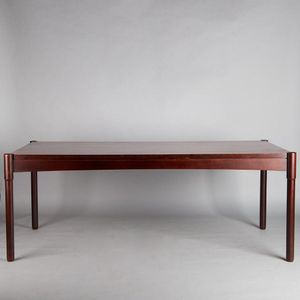Organic Modernism Dining Table
A Rudi Schwartz rosewood and mahogany dining table, stunning in its simplicity, this memorable dining table is an ode to the restrained beauty of organic modernism. It's the perfect place to entertain guests and a unique example of mid-century New Zealand design, height 71 cm, length 183 cm, width 95 cm
You must be a subscriber, and be logged in to view price and dealer details.
Subscribe Now to view actual auction price for this item
When you subscribe, you have the option of setting the currency in which to display prices to $Au, $US, $NZ or Stg.
This item has been sold, and the description, image and price are for reference purposes only.
- Modernism / Modernist - Modernist furniture and design emerged in the early to mid-20th century as a response to traditional styles of the 19th century and prior times, and a reflection of the technological and social changes of the time. Characteristics of Modernist furniture and design include simplicity and minimalism and clean lines and a lack of unnecessary ornamentation are key features. That form follows function is a fundamental principle of Modernist design, and furniture and objects are designed with a focus on their practical use.
Modernist furniture often incorporates geometric shapes, such as cubes, rectangles, and circles. This reflects a departure from the more ornate and curvilinear forms of previous design styles. The furniture often prioritizes ergonomic design, ensuring that objects are comfortable and user-friendly. Modernist designers aimed to create designs that could be mass-produced, making good design accessible to a broader population.
Prominent figures associated with Modernist furniture and object design include designers such as Hans Wegner, Verner Panton, Florence Knoll, Harry Bertoia and Ettore Sottsass - Rosewood - A dense timber that varies in shade to very light brown to almost black. When rosewood is cut and sanded the colour of the timber will turn black, and after polishing and exposure to daylight, the surface will gradually lighten over time to light brown with black streaks.
The name comes from the odour emanating from the timber when it is planed, sanded or cut.
Rosewood was very popular for use in Victorian furniture in the second half of the 19th century, and at that time most of the rosewood was imported from Brazil. However it also grows in India and Indonesia.
It is used in the sold for chairs and table legs, but for carcase furniture such as side cabinets and bookcases, and for table tops it is always used as a veneer. - Mahogany - Mahogany is a dense, close grained red-coloured timber from the West Indies and Central America. It was first imported into Europe in the the early 18th century and its use continued through the 19th century. It was popular for furniture making because of its strength, the wide boards available, the distinctive grain on some boards, termed flame mahogany and the rich warm colour of the timber when it was polished.. The "flame" was produced where a limb grew out from the trunk of the tree, and this timber was usually sliced into veneers for feature panels on doors, backs and cornices.
Some terms used to describe mahogany relate to the country from which it originally came, such as "Cuban" mahogany, "Honduras" mahogany etc. However unless the wood has been tested the names assigned are more a selling feature, rather than a true indication of the timber's origin.
This item has been included into following indexes:
